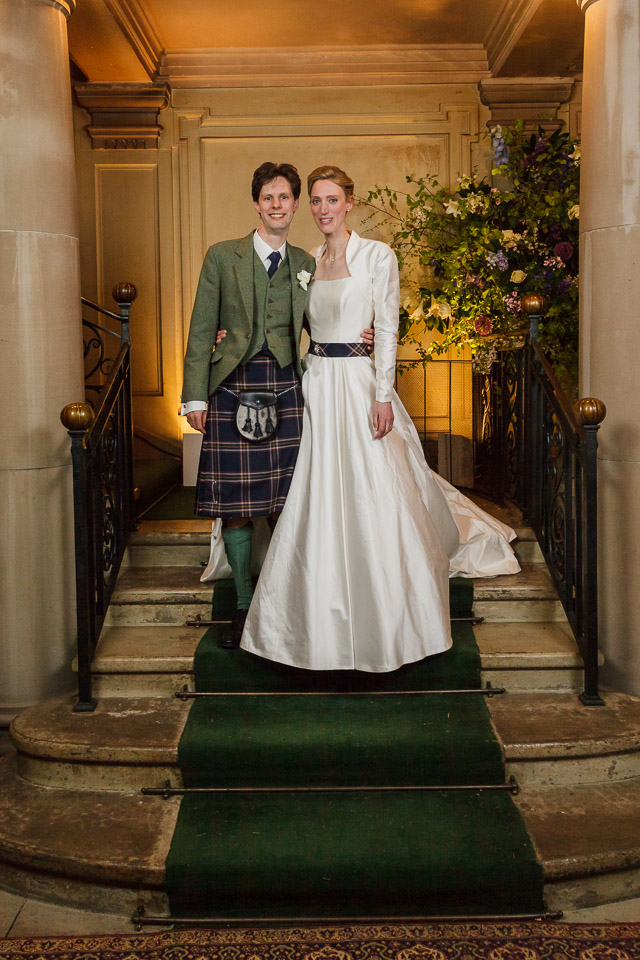



Crichton Tartan
 The Crichton badge dates from the medieval period. Tartan in Scotland traditionally had less connection to individual families, and was worn more as we choose individual material today. However it was outlawed following the Jacobite rebellion, and slowly became associated with individual clans in the 19th Century. The Crichton clan did not take part in this 19th Century romantic ideal and was slow to design its own tartan.
The Crichton badge dates from the medieval period. Tartan in Scotland traditionally had less connection to individual families, and was worn more as we choose individual material today. However it was outlawed following the Jacobite rebellion, and slowly became associated with individual clans in the 19th Century. The Crichton clan did not take part in this 19th Century romantic ideal and was slow to design its own tartan.
The present clan chief had the Crichton tartan designed for the state sponsored Clan Gathering in Edinburgh in 2009. We designed the tartan in conjunction with the Scottish Tartan Authority. Our tartan is woven by Strathmore Woollens who makes our kilts too. We are always delighted to help you in buying a Crichton kilt. If you are interested in other items such as ties, scarves and hats, drop us an email at info@clancrichton.org, and we will let you know if we have stock available.



Current Clan Chief
David Crichton of that Ilk is the current clan chief. He and his wife Alexandra divide their time between London and Scotland, the latter to enjoy the rich built and natural environment of the land of our forefathers and clan. David can be reached via the contact tab.



Castles
We would strongly recommend any clan members to visit the two clan Crichton strongholds near Edinburgh, as they are wonderfully evocative and resonant buildings in themselves.
Crichton Castle was the original clan stronghold, and is perched on a bluff overlooking a small valley, about 10 miles south of Edinburgh. You can clearly see how the clan and William Crichton’s fortunes in particular grew from a local squire to national importance. There were other inhabitants after the Crichton clan, but it is essentially unchanged since the 16th Century.
Blackness Castle is on the shores of the Forth, and was built by George Crichton, a contemporary of William’s, actually in the shape of a ship! It was eventually seized by the King after a siege, and became a royal castle. However the bleakness of its position meant it was better suited as a prison than a residence. The prison cell which is washed out by the tidal waters of the Forth every day is not a pleasant proposition! It eventually became an ammunition store for the Rosyth naval base which is on the shore opposite, and was restored in a rustic manner in the 1920s.
Monzie Castle is the present seat of the Clan Chief and his family, and is near Perth. It comprises a 17th Century L shaped house, and an 18th Century mansion with turrets. The structure suffered a serious fire in 1911, and the interiors were rebuilt by the architect Sir Robert Lorimer. It is open to the public in May/June each year, so please get in touch for details.



Jacobite rebellions
The Crichton clan were most definitely on the side of the Stuarts during the upheavals of the 17th Century. The ancestors of the chief’s family were based in Aberdeenshire at this point, and James Crichton was created 1st Viscount Frendraught by Charles I in Nottingham on 29th August 1642, for showing his support for the royalist cause.
Lewis the 4th Viscount Frendraught fought for the Jacobites in 1688, and by taking and holding the castle of Federate in Buchan, was the last stronghold to be held for King James in Scotland. Inevitably he was shown little mercy, stripped of land and titles, and exiled to France. Another Crichton, James was a colonel in Bonny Prince Charlie’s army, and was ordered to garrison Carlisle castle on the retreat north. At the end of the rebellion, he too was forced into exile in France.



The Admirable Crichton
James Crichton was a spectacular prodigy, whose epithet ‘Admirable’, hard won in his own lifetime, has been unfortunately appropriated by a butler in JM Barrie’s play, and by a modern day London catering company! James Crichton was born in 1560 in Dumfriesshire, and his father Robert was Lord Advocate of Scotland from 1562 to 1582. Schooled in Perth, he entered St Andrews university at 9, became a Bachelor of Arts at 12, and a Master at 14. He was then chosen to be a youthful companion of King James VI, then aged 9, but shortly after left Scotland for France, where it is believed he spent some time in the French army.
By 1580 and based in Venice, he had built himself a spectacular reputation in Italy, for his ability to discourse and dispute with the leading professors of the day, in a multitude of languages, and in a charming manner. To be an intellectual adventurer was not uncommon in those days, but surviving three days of disputation, as he did in Padua in March 1581, remains an astounding achievement. In 1582 he entered the service of the Duke of Mantua, but on a hot night in July 1582 was murdered in a street brawl by the Duke’s thuggish son, Prince Vincenzo.



William Crichton
The 15th Century saw the clan’s name indelibly associated with Scottish national history, through the exploits of William Crichton. First records are of him in 1423 joining a company of Scottish nobles in escorting King James I back from captivity in England, and being knighted at the subsequent coronation. In 1426 Sir William played a key role in the negotiation of a peace treaty with Eric, King of Norway and Denmark, for which was appointed Governor of Edinburgh Castle. Soon after the accession of the young James II, he was appointed Lord Chancellor, the highest political office in the land, and one of the very first non ecclesiastical appointments.
At this time Scottish politics was no place for the weak hearted, and no less a judge than Sir Walter Scott called William ‘a consummate statesman of the age, as destitute of faith, mercy and conscience as of fear and folly’. We note the fateful dinner at Edinburgh Castle, where the young Earl of Douglas and his brother were seized following the serving of a black bull’s head, tried and executed for treason in front of the king. As a clan, we reiterate we always acted with the king’s interests at heart!
Indeed Sir William was later ennobled as the first Lord Crichton, and then in 1448 undertook a diplomatic visit to France, to ratify the ancient entente with that country, and to choose James II a bride. The ratification of the entente was a success, but there was no French princess available, so they proceeded to Burgundy, where they secured the hand of Mary of Gueldres. She returned to Scotland with the Chancellor on 18th June 1449, and the marriage took place on the 3rd July, illustrating there is nothing new about the drama of a royal wedding! Lord Crichton remained in office until his death sometime prior to 1454.



Origins of the Clan
The ancient history of Scotland is shrouded in mystery, and the origins of the Crichton clan are no exception. We do know that the lands of Crichton, in the hills behind Edinburgh, are the first recorded use of the name, and clansmen are likely to have had an ancestor from the district.
The proximity to Edinburgh allowed members of the clan to play prominent parts in Scottish medieval history. The first written mention is of Turstan de Crectune, a witness to the great charter of Holyrood in 1140. As written records pick up in the next two centuries, we slowly find more mention of clan members.
For example Nicholas de Creyghton was one of an inquest in 1311-2, appointed by Edward II of England, to determine the value of certain lands in the Lothians belonging to supporters of Robert I ,and who was also a member of the garrison of Edinburgh Castle, and who possessed a horse described as ‘badium cum stella’. Other examples of political service include John de Crichton, who was appointed sherrif of Kinross and keeper of Lochleven castle in 1359. Various members of the clan acquired land in other parts of Scotland, with Sanquhar in Dumfriesshire inherited by one as a result of marriage, and another ultimately founding the house of the Earl of Erne in Ireland.


